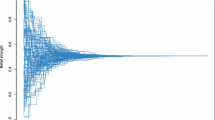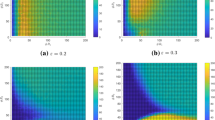Abstract
If we want to understand how extremist group ideologies are established, we have to comprehend the social processes which form the basis of the emergence and distribution of such beliefs. In our chapter, we present an innovative approach to examining these processes and explaining how they function: with the method of computer-based simulation of opinion formation, we develop heuristic explanatory models which help to generate new and interesting hypotheses. The focus is thereby not on individuals and their idiosyncrasies but on the dynamic mutual adaptation of beliefs in a group. These dynamics can produce an incremental establishment of “charismatic” opinion leaders and an increasing radicalization and alienation. A prototype of such a simulation model has produced promising first results which are presented and discussed.
Access this chapter
Tax calculation will be finalised at checkout
Purchases are for personal use only
Similar content being viewed by others
Notes
- 1.
Russell Hardin does not like the term “trust ” in this context because he wants to reserve the use of this term for relations with “strong” ties (Hardin 2009, 26). Insofar we use a thin concept of trust which also includes relations which are impersonal but share important aspects with personal trust relations such as dependence or risk-taking. However, this is a terminological, not a substantial point of departure (cf. Baurmann 2010b).
- 2.
The explanatory significance of such modeling is discussed in a special issue of Erkenntnis (vol. 70, no. 1, January 2009) “Economic Models as Credible Worlds or as Isolating Tools?” with contributions among others by Nancy Cartwright, Till Grüne-Yanoff, Tarja Knuuttila and Robert Sugden.
- 3.
For an application of this model to a “veritistic” issue cf. Betz et al. (2013).
- 4.
In this prototype, we do not differentiate between the attribution of competence and veracity but subsume both under “competence”.
- 5.
But in contrast to the Lehrer-Wagner model, the competence degrees are not used in our model as weights for averaging but only to select trustworthy persons.
- 6.
Deffuant et al. (2002) and Deffuant (2006) refine the bounded-confidence model to study the dynamics of polarization and radicalization processes but they do not consider second-order opinions. The same applies to a recent publication by Hegselmann and Krause (2015) in which they explicitly deal with the dissemination of extremist beliefs but without including the formation of epistemic trust relations.
- 7.
Technically the charismatic leader P5 is not removed from the simulation but becomes part of the mainstream.
References
Baurmann, M. 2007. Rational Fundamentalism? An Explanatory Model of Fundamentalist Beliefs. Episteme: Journal of Social Epistemology 4: 150–166.
———. 2010a. Fundamentalism and Epistemic Authority. In Democracy and Fundamentalism, The Tampere Club Series, ed. A. Aarnio, vol. 3, 71–86. Tampere: Tampere University Press.
———. 2010b. Kollektives Wissen und epistemisches Vertrauen. Der Ansatz der Sozialen Erkenntnistheorie. Kölner Zeitschrift für Soziologie und Sozialpsychologie. 50 (Sonderheft): 185–201.
Baurmann, M., G. Betz, and R. Cramm. 2014. Meinungsdynamiken in fundamentalistischen Gruppen. Erklärungshypothesen auf der Basis von Simulationsmodellen. Analyse & Kritik 36: 61–102.
Betz, G. 2006. Prediction or Prophecy? The Boundaries of Economic Foreknowledge and Their Socio-Political Consequences. Wiesbaden: Deutscher Universitats-Verlag.
———. 2010. Theorie dialektischer Strukturen. Frankfurt am Main: Vittorio Klostermann Verlag.
Betz, G., M. Baurmann, and R. Cramm. 2013. Is Epistemic Trust of Veritistic Value? Etica & Politica – Ethics & Politics XV: 25–41.
Deffuant, G. 2006. Comparing Extremism Propagation Patterns in Continuous Opinion Models. Journal of Artificial Societies and Social Simulation 9 (3).
Deffuant G., F. Amblard, G. Weisbuch, and T. Faure. 2002. How Can Extremism Prevail? A Study Based on the Relative Agreement Interaction Model. Journal of Artificial Societies and Social Simulation 5 (4).
Hardin, R. 1992. The Street-Level Epistemology of Trust. Analyse & Kritik 14: 152–176.
———. 2002. The Crippled Epistemology of Extremism. In Political Extremism and Rationality, ed. A. Breton et al., 3–22. Cambridge: Cambridge University Press.
———. 2009. How Do You Know?: The Economics of Ordinary Knowledge. Princeton: Princeton University Press.
Hedström, P., and R. Swedberg, eds. 1998. Social Mechanisms. Cambridge: Cambridge University Press.
Hedström, P., and P. Ylikoski. 2010. Causal Mechanisms in the Social Sciences. The Annual Review of Sociology 36: 49–67.
Hegselmann, R. 2004. Opinion Dynamics – Insights by Radically Simplifying Models. In Laws and Models in Science, ed. D. Gillies, 19–46. London: King’s College Publications.
Hegselmann, R., and A. Flache. 1998. Understanding Complex Social Dynamics: A Plea for Cellular Automata Based Modelling. Journal of Artificial Societies and Social Simulation 1 (3).
Hegselmann, R., and U. Krause. 2002. Opinion Dynamics and Bounded Confidence: Models, Analysis and Simulation. Journal of Artificial Societies and Social Simulation 5(3).
———. 2006. Truth and Cognitive Division of Labour First Steps Towards a Computer Aided Social Epistemology. Journal of Artificial Societies and Social Simulation 3 (9).
———. 2015. Opinion Dynamics Under the Influence of Radical Groups, Charismatic Leaders, and Other Constant Signals: A Simple Unifying Model. Networks and Heterogenous Media 10: 477–509.
Lehrer, K., and C. Wagner. 1981. Rational Consensus in Science and Society: A Philosophical and Mathematical Study. Dordrecht: D. Reidel.
Author information
Authors and Affiliations
Editor information
Editors and Affiliations
Appendices
Appendix 1: The Model
The model describes the collective opinion formation in a group of n persons (G = {1, …, n}) in discrete time steps (t = 0, 1, …). Each person i ∈ G at a given point of time t has precisely one first-order opinion, x i (t) ∈ (with j = 1, …, n), and n second-order opinions, y {i,j}(t) ∈ [0.1] (with j = 1, …, n). The set V i (t) of all group members who are trusted by person i at time t is defined as:
whereby ε ∈ ℝ is a confidence parameter. The first- and second-order opinions of a person i are modified according to the following dynamic rules
Appendix 2: Numeric Specification of the Simulation Experiments
A simulation experiment is numerically completely specified by
-
the group size n,
-
the confidence interval ε,
-
the initial first-order opinions
the initial second order opinions
-
Emergence of extremist groups (Fig. 1 )
-
Group size: n = 10,
-
Confidence interval: ε = 0.33,
-
Initial first- and second-order opinions:
-
-
Emergence of extremist groups (Fig. 2 )
-
Group size: n = 10,
-
Confidence interval: ε = 0.33,
-
Initial first- and second-order opinions:
-
-
Stability of extremist groups, endogenous stable situation with charismatic leader (Fig. 3, t = 0)
-
Group size: n = 10,
-
Confidence interval: ε = 0.25,
-
Initial first- and second-order opinions:
-
-
Stability of extremist groups, without charismatic leader (Fig. 3, t >0)
-
Group size: n = 10,
-
Confidence interval: ε = 0.25,
-
Initial first- and second-order opinions:
-
-
Stability of extremist groups, endogenous stable situation with charismatic leader (Fig. 4, t = 0)
-
Group size: n = 10,
-
Confidence interval: ε = 0.25,
-
Initial first- and second-order opinions:
-
-
Stability of extremist groups, without charismatic leader (Fig. 4, t > 0)
-
Group size: n = 10
-
Confidence interval: ε = 0.25
-
Initial first- and second-order opinions:
-
Rights and permissions
Copyright information
© 2018 The Author(s)
About this chapter
Cite this chapter
Baurmann, M., Betz, G., Cramm, R. (2018). “Führer befiehl, wir folgen dir!” Charismatic Leaders in Extremist Groups. In: Christiano, T., Creppell, I., Knight, J. (eds) Morality, Governance, and Social Institutions. Palgrave Macmillan, Cham. https://doi.org/10.1007/978-3-319-61070-2_10
Download citation
DOI: https://doi.org/10.1007/978-3-319-61070-2_10
Published:
Publisher Name: Palgrave Macmillan, Cham
Print ISBN: 978-3-319-61069-6
Online ISBN: 978-3-319-61070-2
eBook Packages: Political Science and International StudiesPolitical Science and International Studies (R0)




